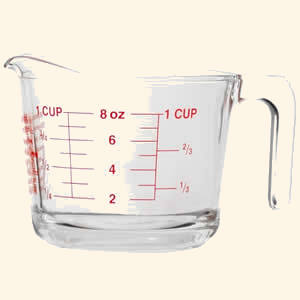
Use the data tables below to assist you with converting your recipe ingredients from cups to grams or vice-versa. Thats over 3 US cups more milk when you pay in pounds instead of dollars.

But that difference becomes much more noticeable when you consider a gallon of milk which in the US is 3785 ml versus 4546 ml in Britain.
How much is a cup in baking terms. One cup is equal to 12 pound of a dry ingredients. In fluids it is the same as 12 pint. In American cooking many of the measurements that equal 1 cup are the same for dry and liquid substances.
For instance 16 tablespoons equal 1 cup if either flour or milk is used. In those circumstances I found it very difficult to calculate 50 of 34 cup or to measure 50 of 15 tablespoon etc. Then I found this handy table in my Baking for Dummies book.
For instance 34th of a cup is equal to 12 tablespoons so half of it would be 6 tablespoons. Here are the frequently asked questions on baking measurements. Baking conversions for cake flour from cups to grams Cake flour is lighter than all-purpose flour and so 1 cup of cake flour weighs 115 grams.
For chestnut flour 1 cup weighs 115 grams as well. This conversion also applies to chopped nuts. 1 cup of chopped nuts weighs 115 grams.
Here is the food scale she uses for common ingredients. 1 cup all purpose flour 125 grams 4 12 ounces 1 cup sifted all purpose flour 115 grams 4 ounces 1 cup bread flour 130 grams 4 12 ounces. A heaping cup is 1 cup plus 1-2 tablespoons for liquid measures it is called a generous cup and a scant cup is 1 cup minus 1-2 tablespoons.
We have already posted some basic conversions from cups to weight for common items like flour and sugar. Instead of struggling and second-guessing simply convert the liquid metric measurements to fluid ounces and then if need be convert to cups tablespoons or teaspoons. The conversions are rounded to the nearest whole number.
For example 1 fluid ounce is 2957 milliliters but for simplicity sake we will say 30 milliliters. You can use a dry measuring cup. This features a 1 cup ½ cup ⅓ cup and ¼ cup measure suitable for almost all baking ingredients.
If you measure dry ingredients like flour or sugar you will have to use a basic spoon. Also keep in mind that you should level. The process of bringing a liquid to a temperature that is slightly below its boiling point and letting it bubble gently.
Noun the outer layer of a fruit vegetable or meat. Verb to remove the outer layer of a fruit vegetable or meat. Baking Conversion Chart - Cups Metric Imperial free printable Published.
Jan 7 2017 Modified. Oct 1 2019 by Lucy This post may contain affiliate links 7 Comments. An easy to use Baking Conversion Chart with all the most common baking ingredients - including cups metric imperial measurements grams ounces plus a FREE printable.
If you love finding recipes online. 14 cup 55g. 12 cup 112g.
1 cup 225g. 2 cups 450g. 1 stick 113g.
The number of grams in one cup varies depending upon the ingredient due to ingredient density. For flour 1 cup equates to around 125g. For sugar 1 cup equates to around 200g.
Use the data tables below to assist you with converting your recipe ingredients from cups to grams or vice-versa. Recipes from the USA often display baking measurements in Cups but how do they convert to the imperial and metric measurements more commonly used in the UK. Precise measurements are so important in baking so weve created several baking conversion charts to help you out.
Volume of Liquid Ingredients. US Cups Millilitres Fluid Ounces. We tend to give cup sizes as a measrue of volume rather than weight as different ingredients will have different weights per cup depending on their density.
Nigellas own cups and those in her Kitchen Kit range have volumes of 1 cup 250 mls9 fl oz 12 cup 125 mls4 12 fl oz 13 cup 80 mls3 fl oz 14 cup 60 mls2 14 fl oz. But that difference becomes much more noticeable when you consider a gallon of milk which in the US is 3785 ml versus 4546 ml in Britain. Thats over 3 US cups more milk when you pay in pounds instead of dollars.
So pay close attention to the origin of the recipe youre using since the author may be speaking a different language of measurement. 8 x 2 inches. 20 x 5 cm.
9 x 1 12 inches. 23 x 4 cm.